|
Ice & Fire: major changes brought by global warming
Left image
Right image
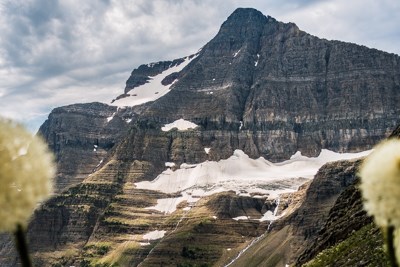
Less IceThe most notorious impact of climate change in the park is shrinking glaciers. For thousands of years, the glaciers naturally cycled through periods of advance and retreat. The park’s current glaciers were at their largest at the end of the Little Ice Age (around 1850) then started to retreat with the onset of a warming trend. While the decrease of glaciers since the end of the Little Ice Age is due to both natural and human-caused climate change, the retreat seen in recent decades can be increasingly attributed to anthropogenic causes. In this way, we have an opportunity to witness and study the power of climate change, both natural and not. 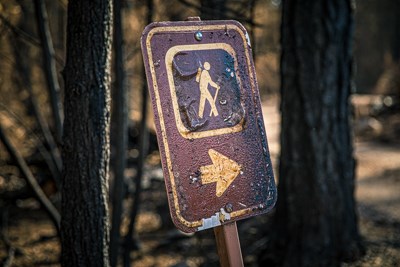
More FireImagine visiting the park to find your favorite view obscured by smoke or whole areas closed for public safety. Imagine struggling to breathe or having to evacuate your campsite in the middle of the night. In recent years, many visitors to Glacier have experienced all of these things. Scientists estimate that climate change has doubled the amount of acres burned in western US wildfires since the 1980s. This trend, including an increase in size, frequency, and severity of wildfires, is expected to continue. Other Climate Change ImpactsThis list is incomplete and not limited to Glacier because climate change impacts nearly everything. The US Department of Defense calls climate change a “threat multiplier.” While it does create new problems, climate change more often exacerbates or intensifies existing challenges. In this way, Glacier may remain an enjoyable place for you to visit, and for wildlife to live, despite a changed climate. However, many of the challenges already confronting both people and wildlife, are now being intensified by climate change.Glacier may not have a reputation as a hot place, but increasingly hot days have created a health hazard for unprepared hikers. Once rare, days over 90ºF are becoming more common. In 2020 West Glacier experienced 11 days that hot. Such hot days can pose dangers for hikers on shadeless trails with limited access to water, like the Loop Trail and the Highline Trail. Climate change also degrades air quality, which can cause negative impacts for people participating in strenuous outdoor activities like hiking or bicycling. Smoke from increasingly frequent and severe wildland fires can intensify respiratory and cardiopulmonary illnesses. Additionally, longer growing seasons, warmer temperatures, and elevated carbon dioxide levels have increased pollen levels, worsening allergies and asthma.
Longer and more intense fire seasons produce smoke events that, in addition to being a health hazard, can dramatically reduce visibility and diminish the park’s famous views. At night, air pollution scatters artificial light—increasing the impact of light pollution to the night sky and threatening the park’s dark skies.
Climate change is expected to increase the range of ticks and mosquitoes in the US, thereby increasing the number of people exposed to the diseases that they transmit. Increased summer drought will likely increase cases of West Nile virus in Montana. Longer droughts, warmer temperatures, and minimal change in average annual precipitation favor both the virus and the primary vector, mosquitos. Research has connected rising temperatures to worsening mental health and declining cognitive functioning. Beyond that, higher temperatures also lead to increased interpersonal violence and suicide. Even small increases to average monthly temperatures can lead to significant increases in mental illness. Likewise, major climatic events, like wildland fires, have been shown to increase cases of posttraumatic stress disorder, anxiety, depression, substance abuse, and suicidal thoughts.
Though many factors influence visitation to national parks, research shows that, in general, visitation to parks is also tied to the climate. People tend to go on trips in the summer when the weather is nicer. Climate change lengthens the summer season and increases the period of time in which most people like to visit Glacier National Park. Since 2010, visitation to Glacier has risen dramatically, from under two million yearly visitors to over three million. Mountain goats in Glacier National Park rest on snow patches to cool down on hot days. Doing so helps them slow their breathing and conserve energy. Climate change raises temperatures and shrinks snow patches. Researchers worry that these changes could lead to greater stress on the park’s cold-adapted goats.
Reduction in mountain snowpack due to climate change poses a threat to many snow‐adapted species worldwide. Wolverines den in snow in late winter and spring. Declining snowpack levels in the lower half of wolverine denning elevations has caused some concern for this species. However, their higher denning habitat is expected to retain springtime snowpack through mid-century. Throughout their evolutionary history, pika have moved up or down in elevation during periods of climate warming or cooling. This cold-adapted species is sensitive to summer heat but also relies on winter snowpack for insulation from cold winter temperatures. Increasing temperatures or decreasing snowpack could reduce the amount of suitable pika habitat, especially at the southern latitudes and lower elevations of their range, in Nevada and Utah, for example.
White-tailed ptarmigan have adapted to life in the alpine cold, but may be less well-adapted to hot summer temperatures. Between the 1990s and the 2010s, Glacier National Park saw declines in the of number flocking ptarmigan, and the average flock location moved hundreds of meters up in elevation.
Climate change alters the timing of some of Glacier's natural processes, like spring water runoff. If species of concern, like Harlequin ducks, can't adapt to these changes they could experience declines. Since Harlequins nest very close to streams and depend on clear waters to feed, changes in the timing of spring runoff put them at risk of reduced reproduction.
The Black Swift, a Montana Species of Concern, is the largest of the swift species north of Mexico but the least studied. These swifts nest behind waterfalls, so the reduction of glaciers and permanent snowfields could shrink their breeding habitat. Additionally, since they rear only one chick at a time, they are slow to adapt to challenges.
Some alpine flowers like the Jones’ columbine (Aquilegia jonesii) and alpine glacier poppy (Papaver pygmaeum) are dependent on the meltwater from permanent or semi-permanent snowfields. As these snowfields shrink and eventually disappear, these plants could vanish along with them. Long-term monitoring projects going back to the 1980s have already detected a significant decline in many alpine plant species.
These cold-adapted fish are facing a variety of threats. Climate change impacts bull trout in several ways besides heating the waters they depend on being cold. Lower summer water levels and increases in winter flooding are potential climate impacts to bull trout. Additionally, increases in wildland fire, that burn away stabilizing vegetation, can increase debris flows and sediment loads, posing another threat to these trout.
These cold-loving insects live at high elevations usually within a few hundred meters of a glacier or snowfield and cannot tolerate warm water temperatures. Climate change has shrunk the snow and ice that these stoneflies depend on, fragmenting and shrinking their habitat in Glacier National Park.
Cold water is actually a decent place for archeological artifacts to remain preserved. Fluctuating lake levels caused by droughts pose a threat to archeological sites in shallow waters, where exposure to ambient air could encourage deterioration. Water temperature also affects deterioration of organics and metal corrosion. Without considering biological effects, corrosion rates of metals approximately double for every 10°C temperature rise. Temperature also controls how much ice forms. The presence of ice reduces oxygen levels in the water. If rising temperatures reduce winter ice cover, oxygen levels in the water could rise and encourage faster artifact deterioration.
Warmer stream temperatures seem to be helping increase the spread of a type of freshwater algae named Didymosphenia geminata, commonly known as didymo, or “rock snot”. Didymo, although native to Glacier, can cause nuisance blooms that may inhibit the growth of other algae, change the appearance of rivers, decrease suitable habitat for spawning fish, and change stream chemistry.
Less Ice Carrara, Paul E. (1993). Glaciers and Glaciation in Glacier National Park, Montana (Open File Report 93-510 USGS-OFR-93-510; p. 18). United States Geological Survey. https://pubs.usgs.gov/of/1993/0510/report.pdf Pp. 2. “Deglaciation of the Glacier National Park region is thought to have been completed more than 10,000 years ago… By 10,000 years ago, remaining glaciers probably were confined to those cirques and well-shaded niches where present-day glaciers and snowfields lie. During the next several thousand years, temperatures in the Glacier National Park region were several degrees warmer than they are now and there were fewer glaciers. Some of the larger glaciers may have survived this warm period, but many of the park's smaller glaciers probably did not exist at this time. This warm period ended sometime between 5,000 and 3,000 years ago. After it ended existing glaciers probably increased in size, others may have been formed.” Pederson, G. T., Fagre, D. B., Gray, S. T., & Graumlich, L. J. (2004). Decadal-scale climate drivers for glacial dynamics in Glacier National Park, Montana, USA: Drivers of Glacial Dynamics. Geophysical Research Letters, 31(12). https://doi.org/10.1029/2004GL019770 Pp. 3. “After A.D. 1850 a long period (1860–1890) of low winter accumulation potential (warm North Pacific) and high summer ablation potential overlap, producing conditions favorable for negative annual mass-balance and the start of glacial retreat.” Marzeion, B., Cogley, J. G., Richter, K., & Parkes, D. (2014). Attribution of global glacier mass loss to anthropogenic and natural causes. Science, 345(6199), 919–921. https://doi.org/10.1126/science.1254702 Pp. 919. Writing about glacier retreat globally, “glacier response times are typically decades or longer, which implies that the present-day glacier retreat is a mixed response to past and current natural climate variability and current anthropogenic forcing. Here we show that only 25 ± 35% of the global glacier mass loss during the period from 1851 to 2010 is attributable to anthropogenic causes. Nevertheless, the anthropogenic signal is detectable with high confidence in glacier mass balance observations during 1991 to 2010, and the anthropogenic fraction of global glacier mass loss during that period has increased to 69 ± 24%.” More Fire John T. Abatzoglou, A. Park Williams Proceedings of the National Academy of Sciences Oct 2016, 113 (42) 11770-11775; DOI: 10.1073/pnas.1607171113 “We demonstrate that human-caused climate change caused over half of the documented increases in fuel aridity since the 1970s and doubled the cumulative forest fire area since 1984. This analysis suggests that anthropogenic climate change will continue to chronically enhance the potential for western US forest fire activity while fuels are not limiting.” Hiking Adams, Alexandra, Robert Byron, Bruce Maxwell, Susan Higgins, Margaret Eggers, Lori Byron, and Cathy Whitlock. “Climate Change and Human Health in Montana: A Special Report of the Montana Climate Assessment.” Montana State University, December 8, 2020. https://doi.org/10.15788/c2h22021 Pp. XVIII. “Annual temperatures have risen 2-3ºF (1.1-1.7ºC) since 1950, and our growing season is now 12 days longer. Montana has experienced an increase in warm days and nights, both in summer and winter… The number of days >90ºF (>32ºC) will increase significantly by the end of the century, with the greatest warming in eastern Montana.” Eberhardy, Ed, Physical Science Technician, Unpublished personal communication, Glacier National Park, February 2, 2021. “West Glacier, # Days Above 90F, 2020 11.” Breathing Adams, Alexandra, Robert Byron, Bruce Maxwell, Susan Higgins, Margaret Eggers, Lori Byron, and Cathy Whitlock. “Climate Change and Human Health in Montana: A Special Report of the Montana Climate Assessment.” Montana State University, December 8, 2020. https://doi.org/10.15788/c2h22021 Pp. 37. “Separately, but related to air quality concerns, pollen counts in the United States are increasing with projections for doubling by 2040 (Zhang et al. 2015) due to warming temperatures with longer growing seasons (Ziska et al. 2019), and higher atmospheric carbon dioxide levels (Ziska and Caulfield 2000). In addition to worsening seasonal allergies, this increase in pollen poses risks of triggering exacerbations of asthma, which affects 9.1% and 6.8% of Montana adults and children, respectively (MTDPHHS 2013).” Pp. 38. “Large fires with adverse impacts on communities throughout the western US, including Montana, are increasing as measured in numbers of acres burned (Figure 3-5) because a) climate warming produces longer, drier fire seasons and extensive burning; and b) patterns of human development are increasing human exposure to wildfires (Abotzoglou and Williams 2016; Radeloff et al. 2018). In Montana, increased fire activity in recent decades has impacted people through an increase in hazardous air quality from wildfire smoke, originating locally or from distant sources (see, for example, Figure 3-6). For the western US, including Montana, warmer and drier conditions during summer have contributed to longer fire seasons and more area burned by wildfires, producing more and longer smoke events (Dennison et al. 2014; Westerling 2016; Dalton et al. 2017). Smoke events in the western US from 2004–2009 were associated with a 7.2% increase in respiratory hospital admissions among adults over 65 yr of age (Liu et al. 2017).” Diminished Views Adams, Alexandra, Robert Byron, Bruce Maxwell, Susan Higgins, Margaret Eggers, Lori Byron, and Cathy Whitlock. “Climate Change and Human Health in Montana: A Special Report of the Montana Climate Assessment.” Montana State University, December 8, 2020. https://doi.org/10.15788/c2h22021 Pp. 38. “For the western US, including Montana, warmer and drier conditions during summer have contributed to longer fire seasons and more area burned by wildfires, producing more and longer smoke events (Dennison et al. 2014; Westerling 2016; Dalton et al. 2017).” Glacier National Park, Foundation Document, Foundation Document (Montana: National Park Service, U.S. Department of the Interior, October 2016), https://www.nps.gov/glac/learn/management/upload/GLAC_FD_SP.pdf. Pp. 7. “The park’s clean water and air are vital to ecosystem health and to the visitor experience. Clean air allows visitors to see hundreds of miles from the park’s high peaks and to view stunning star filled skies.” Pp. 19. “Forest fires in the area and region occasionally degrade air quality. The impacts are typically short term… At night, air pollution can scatter artificial light—increasing the impact of light pollution to the night sky and threatening the park’s dark skies.” Disease Adams, Alexandra, Robert Byron, Bruce Maxwell, Susan Higgins, Margaret Eggers, Lori Byron, and Cathy Whitlock. “Climate Change and Human Health in Montana: A Special Report of the Montana Climate Assessment.” Montana State University, December 8, 2020. https://doi.org/10.15788/c2h22021 Pp. 49. “Montana had no cases of West Nile virus until 2002. By 2018, the Montana Department of Public Health and Human Services (MTDPHHS) reported 51 cases across 18 counties. Nine counties reported mosquito pools12 that tested positive for West Nile virus out of 30 counties tested (Figure 3-9). Three people have died from West Nile virus in Montana since it was first detected (MTDPHHSc undated). MCA projects longer droughts, warmer temperatures, and minimal change in average annual precipitation, likely concentrated in fewer precipitation events (Whitlock et al. 2017; also see Section 2), factors that favor both the virus and the primary vector, the Culex spp. mosquito (Epstein 2001; Harrigan et al. 2014; Paull et al. 2017). Thus, concern exists for climate change resulting in increased numbers of West Nile virus infections in Montana.” Mental Health Adams, Alexandra, Robert Byron, Bruce Maxwell, Susan Higgins, Margaret Eggers, Lori Byron, and Cathy Whitlock. “Climate Change and Human Health in Montana: A Special Report of the Montana Climate Assessment.” Montana State University, December 8, 2020. https://doi.org/10.15788/c2h22021 Pp. 51. “The mental health impacts of climate change are profound and varied. Elevated temperatures have been related to worsening a) mental health status (Obradovich et al. 2018); b) diminished cognitive function (Laurent et al. 2018); c) increased violence (Clayton et al. 2017); d) increased interpersonal aggression in the form of domestic violence, abuse, and rapes (Hsiang et al. 2013); and e) suicide (Page et al. 2007). Even small increases in temperature, in one case comparing average monthly temperatures between 25-30oC (77-86oF) with those over 30oC (86oF), can lead to significant increases in mental illness (Obradovich et al. 2018). People with preexisting mental illness are at increased risk following weather related events (Trombley et al. 2017), as are youth (Paulson et al. 2015; OrengoAguayo et al. 2019). Likewise, climate “surprises” (see Section 2) such as flooding (Lamond et al. 2015), wildfires, or storms have been shown to impact mental health. Those impacts include increases in posttraumatic stress disorder (PTSD), anxiety, depression, substance abuse, and suicidal thoughts. A sense of community loss and, in many cases, displacement can also result following sudden extreme events, or they may occur over time with slower, sustained climate change impacts (e.g., persistent drought or sea-level rise) (Hayes et al. 2018; Palinkas and Wong 2019). Montana has one of the highest per capita suicide rates in the country (CDC 2018; AAS 2020a,b). This unfortunate reality, coupled with limited access to mental health professionals in most rural areas of the state, greatly heightens the importance of preparedness planning in Montana to address anxiety, stress, and other mental health issues exacerbated by climate change (see facing page). The Montana health workforce does not have widely available access to training on how to address climate anxiety and post-disaster trauma; nor does it have information on the tracking of climate stressors (Doppelt 2016).” Visitation Fisichelli, Nicholas, Gregor Schuurman, William Monahan, and Pamela Ziesler. “Protected Area Tourism in a Changing Climate: Will Visitation at US National Parks Warm Up or Overheat?” PLOS ONE, June 17, 2015. https://doi.org/10.1371/journal.pone.0128226. Pp. 1. “Warming-mediated increases in potential visitation are projected for most months in most parks (67–77% of months; range across future scenarios), resulting in future increases in total annual visits across the park system (8–23%) and expansion of the visitation season at individual parks (13–31 days)... A changing climate is likely to have cascading and complex effects on protected area visitation, management, and local economies.” Mountain Goats Sarmento, Wesley, Mark Biel, and Joel Berger. “Seeking Snow and Breathing Hard – Behavioral Tactics in High Elevation Mammals to Combat Warming Temperatures.” PLOS ONE 14, no. 12 (December 11, 2019): e0225456. https://doi.org/10.1371/journal.pone.0225456. “Individuals 1) selected areas closer to snow on warmer summer days, and 2) on snow had a 15% mean reduction in respiration when accounting for other factors, which suggests remnant snow plays an important role in mediating effects of air temperature. The use of shade was not as an important variable in models explaining respiration. Despite the loss of 85% of glaciers in Glacier National Park, summer’s remnant snow patches are an important reservoir by which animals reduce heat stress and potential hyperthermia.” Wolverines Barsugli, Joseph J., Andrea J. Ray, Ben Livneh, Candida F. Dewes, Aaron Heldmyer, Imtiaz Rangwala, John M. Guinotte, and Stephen Torbit. “Projections of Mountain Snowpack Loss for Wolverine Denning Elevations in the Rocky Mountains.” Earth’s Future 8, no. 10 (October 1, 2020): e2020EF001537. https://doi.org/10.1029/2020EF001537. Pp. 1. “Future reduction in mountain snowpack due to anthropogenic climate change poses a threat to many snow‐adapted species worldwide. Mountain topography exerts a strong control on snowpack not only due to elevation but also through the effect of slope and aspect on the surface energy balance. We develop high‐resolution projections of snowpack in order to provide improved, physically based estimates of the spatial distribution of future snowpack to inform species conservation efforts for the wolverine (Gulo gulo) in two study areas in the Rocky Mountains: one in Montana with known den sites and one in Colorado with recent wolverine activity and potential for reintroduction. Here we assess springtime snowpack loss in actual and potential denning areas under five future climate scenarios for the mid‐21st century. Snowpack in April and May is likely to persist into the mid‐21st century in the upper half of current denning elevations in all but the warmest future climate scenario, while large declines are projected for the lower half of the denning elevations.” Pika Stewart JAE, Wright DH, Heckman KA (2017) Apparent climate-mediated loss and fragmentation of core habitat of the American pika in the Northern Sierra Nevada, California, USA. PLoS ONE 12(8): e0181834. https://doi.org/10.1371/journal.pone.0181834 Pp. 2. “The American pika (Ochotona princeps, hereafter “pika”) is a temperature-sensitive lagomorph species and habitat specialist, which lives primarily in talus habitat (broken rock debris fields) throughout western North America. The species is adapted to cold climates, and possesses a thick coat of fur and limited tolerance for elevated body temperatures, which it regulates behaviorally [14–16]. Paleontological records of distribution show pikas shifting up or down in elevation during periods of climate warming or cooling, respectively [17–20]. The influence of climate-driven range fluctuation has also been observed in pika population genetics [21]. Authors working in the Great Basin, southern Utah, and California, USA, have identified distributional shifts consistent with a response to changes in temperature induced by anthropogenic global warming [22–27], though examples of pikas living in relatively warm, low-elevation sites have also been presented [28–31].” Ptarmigan Benson, David P. Ph.D. and Cummins, M., "Move, Adapt, or Die: Lagopus Leucura Changes in Distribution, Habitat and Number at Glacier National Park, Montana" (2011). Department of Biology. 6. https://mushare.marian.edu/fp_db/6 Pp. 237. “Because of the “montane island” effect and relative rates of climate change, alpine species may be particularly affected by changing climate. White-tailed Ptarmigan (Lagopus leucura) are adapted to life in the alpine cold, but may be less well-adapted to hot summer temperatures. In 1996 and 1997, ptarmigan living in Glacier National Park (GNP) were closely associated with remnant snow and free water in the late summer, a resource that is rapidly changing in distribution and extent as climate changes. We examined White-tailed Ptarmigan distribution, habitat, and numbers in 2009-2010 for comparison with 1996-1997 data. Briefly, five areas within GNP were searched for ptarmigan during August. Habitat data including microclimate were collected at flock locations. Microclimate at ptarmigan flock locations differed from other areas nearby. Flocking ptarmigan appeared to be less numerous than described in 1996 and 1997, and mean flock locations on Logan Pass moved 335 m upslope between the 1990s and 2009 and 2010. Ptarmigan in 2009 and 2010 chose habitat that had the same coverage of vegetation and rock as 1996 and 1997, but contained less snow and water, was farther from snow and water, contained lower soil moisture content, was higher in elevation, and steeper in slope. Our study demonstrates that White-tailed Ptarmigan in GNP have changed distribution, altered habitat preferences, and perhaps on a local scale, experienced declining population numbers in late summer.” Harlequin Ducks Hansen, Warren Kevin, "Causes of annual reproductive variation and anthropogenic disturbance in harlequin ducks breeding in glacier national park, montana" (2014). Graduate Student Theses, Dissertations, & Professional Papers. 4290. https://scholarworks.umt.edu/etd/4290 Pp. 18. "Four stream flow parameters were captured by a single principal component that explained 32% of variation in harlequin reproductive success. All four parameters loaded positively on PC1, so that higher and less predictable flows predict reduced reproductive success. Additionally, all four parameters are predicted to become more extreme with climate change based on previous studies of stream flow and climate change. Based on this result I conclude that this population of breeding harlequin ducks will face significant challenges in future years. We recommend that harlequin populations and habitat be maintained and restored where necessary to allow for dispersal and adaptation into the future." Pp. 20. "These life history traits put harlequins at risk of reduced reproduction with climate change because earlier and more unpredictable spring temperatures may limit foraging ability after arrival and may wash out nests." Black Swifts Cypseloides niger. Montana Field Guide. Montana Natural Heritage Program and Montana Fish, Wildlife and Parks. Retrieved on February 1, 2021, from http://FieldGuide.mt.gov/speciesDetail.aspx?elcode=ABNUA01010 “Species is limited in distribution and requires very specific features for nesting that are rare on the landscape making it vulnerable to extirpation in all or part of its range… Climate change and altered hydrology are probably greatest threats, but human disturbance is probably also an issue since waterfalls are often the destination for hikers… Loss of waterfall habitats due to climate change which, although not fully operational, would be virtually irreplaceable… Virtually all nest areas are dependent on mountain snow pack which is likely to be severely impacted.” Wildflowers Lesica, Peter. MONITORING RARE ARCTIC-ALPINE PLANTS AT THE PERIPHERY OF THEIR RANGE IN GLACIER NATIONAL PARK, MONTANA. Unpublished. Missoula, Montana: Glacier National Park, October 2019. “All but one of the indicator species showed at least a slight decline over the past 30 years.” Bull Trout Salvelinus confluentus. Montana Field Guide. Montana Natural Heritage Program and Montana Fish, Wildlife and Parks. Retrieved on February 1, 2021, from http://fieldguide.mt.gov/speciesDetail.aspx?elcode=AFCHA05020 Native Species of Concern and listed as Threatened “Existing studies suggest that successful incubation of Bull Trout embryos requires cold water temperatures” Falke Jeffrey A., FlitcroftRebecca L., Dunham Jason B., McNyset Kristina M., Hessburg Paul F., and Reeves Gordon H.. Climate change and vulnerability of bull trout (Salvelinus confluentus) in a fire-prone landscape. Canadian Journal of Fisheries and Aquatic Sciences. 72(2): 304-318. https://doi.org/10.1139/cjfas-2014-0098 “Among salmonids in the Pacific Northwest, the bull trout (Salvelinus confluentus) has some of the coldest water requirements (Selong et al. 2001; Dunham et al. 2003a), with the possible exception of the closely related Dolly Varden (Salvelinus malma; Dunham et al. 2008), and is dependent on the presence of large, interconnected habitat patches year-round (Dunham and Rieman 1999). At present, the bull trout is listed as a threatened species under the US Endangered Species Act (ESA; US Fish and Wildlife Service 2008).” Pp. 11. “Although climate projections indicate major losses of suitable bull trout habitat throughout much of the species’ range (e.g., Rieman et al. 2007; Isaak et al. 2012; Wenger et al. 2013), results which the current study supports, our analysis also shows that local management can significantly reduce the vulnerability of this species to climate change. Our findings also differ from a similar previous effort that considered winter flooding, summer low flows, and summer temperature influences on bull trout, in the context of managing nonnative brook trout and climate change impacts (Peterson et al. 2013).” “Wildfire can have an impact on salmonids in streams. In particular, episodic, high-magnitude disturbances (e.g., extreme flooding, debris flows) within days to the first few years following a severe wildfire (Miller et al. 2003; Wondzell and King 2003) can lead to local extirpations (Dunham et al. 2003b).” Pp. 12. “However, given sufficient connectivity, salmonids can recover quickly from wildfire (Rieman et al. 1997; Burton 2005; Dunham et al. 2007; Neville et al. 2009) if suitable environmental conditions exist.” Meltwater Stonefly Lednia tumana. Montana Field Guide. Montana Natural Heritage Program and Montana Fish, Wildlife and Parks. Retrieved on February 1, 2021, from http://fieldguide.mt.gov/speciesDetail.aspx?elcode=IIPLE0K010 “Populations in Glacier National Park appear to be experiencing local population fragmentation and range contractions, possibly linked to a warming climate Ecologically this species is a cold-water stenotherm that is unable to tolerate warm water temperatures (mean temperature exceeding 10 degrees Celsius, maximum temperature exceeding 18 degrees Celsius) and is generally collected within a few hundred meters of the base of glaciers or snow melt derived streams (Muhlfeld et al. 2011). On October 4, 2016 the U.S. Fish and Wildlife Service proposed listing the Meltwater Lednian stonefly under the Endangered Species Act due to primary to threats to the habitat and range of this species including climate change, loss of glaciers and permanent snowfields, and changes in stream flow and water temperature. Specific threats to the populations of Lednia are largely related to global warming and the melting of glaciers and their associated snow melt streams. In general, stonefly populations are affected by changes to aquatic habitat such as alteration of flow patterns, streambed substrate, and thermal characteristics. Treanor et al. (2013) predicted chronic temperature maximas.” Underwater Archeology National Park Service Intermountain Region, Resource Stewardship and Science. Fall, 2016. “Crossroads in Science: Where the Intermountain Region’s Resource Stewardship and Science Programs and Centers Meet.” http://npshistory.com/newsletters/crossroads-in-science/2016.pdf Pp. 49. “Submerged historic structures, shipwrecks, and other underwater cultural sites are vulnerable to climate change impacts, particularly since such sites can be difficult to recognize and their threats easily overlooked. In the NPS Intermountain Region, underwater sites have the additional complication of relative scarcity compared to terrestrial sites. Submerged archeological sites can have different climate change vulnerabilities than terrestrial counterparts.” Pp. 52. “This includes potential impacts to GLAC’s shipwrecks and submerged cultural sites. The park features rich underwater archeology, particularly since the cold fresh water of GLAC’s lakes is an ideal environment for artifact preservation, particularly archeological wood. Notable shipwreck sites include the hull remains of the Fish Creek Bay Wreck and Gertrude, a stern paddlewheel vessel in the north end of Upper Waterton Lake within the Waterton-Glacier International Peace Park (Figures 8 and 9) (Russell 1997).” Pp. 52. “The environment that has maintained GLAC’s shipwrecks in a high state of preservation could be dramatically impacted by climate change. Temperature affects deterioration of organics and metal corrosion; without taking into account biological effects, corrosion rates of metals approximately double for every 10°C temperature rise (North and McLeod 1987:74). Warming holds implications for a number of other preservation impacts. Ice cover encourages winter hypoxia in relatively shallow water, but its elimination and correspondingly increased oxidation would encourage deterioration (Rahel and Olden 2008:526, Wright in press).”
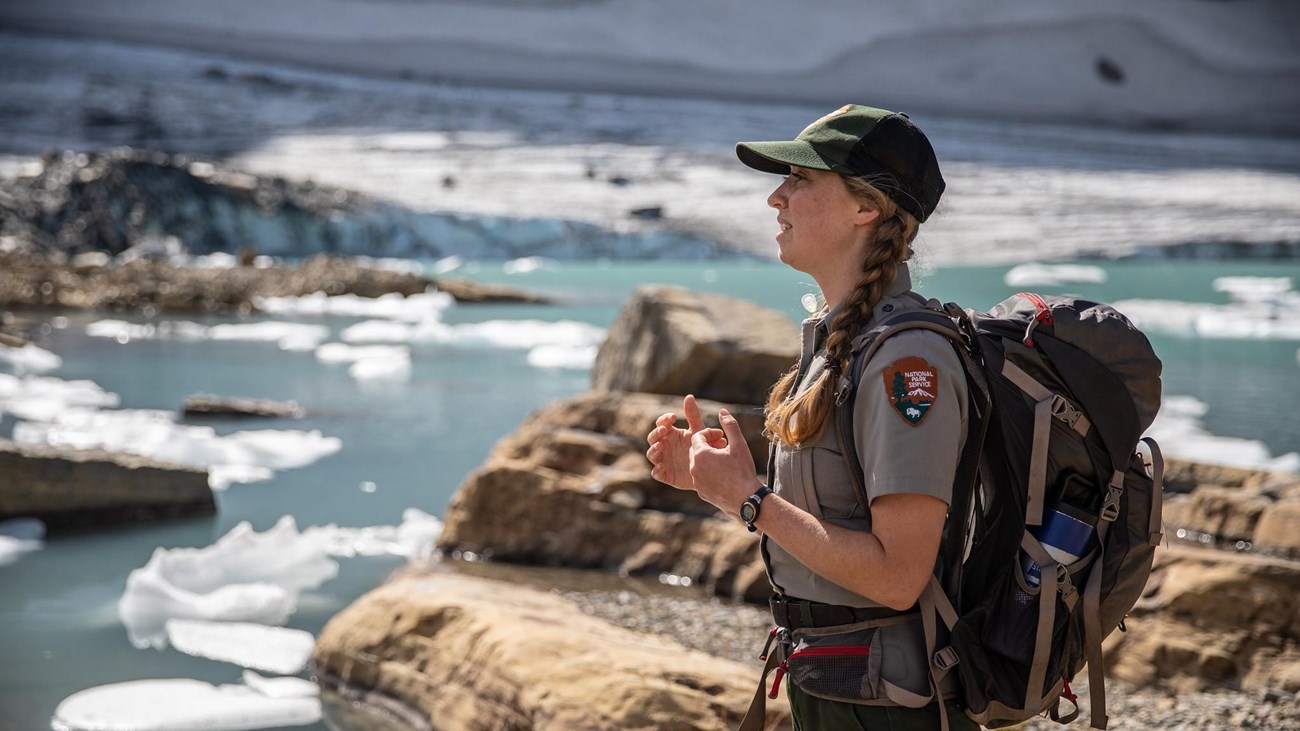
Overview of the Park's Glaciers
Here are the most frequently asked questions about Glacier National Park's glaciers. 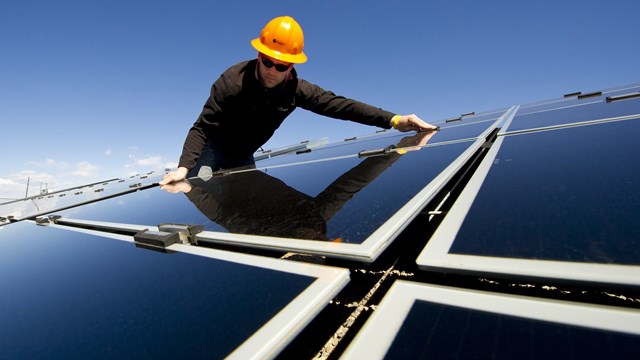
Sustainability
Learn about what Glacier National Park is doing to reduce carbon emissions. 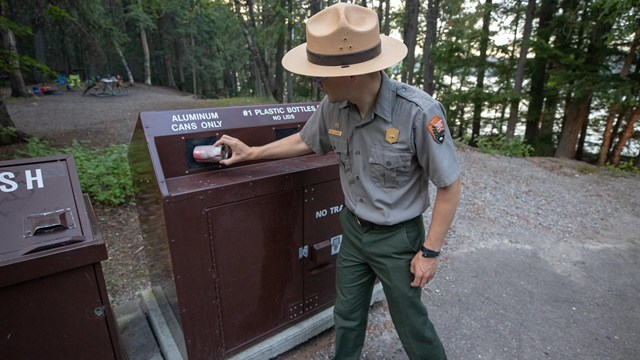
Leave No Trace
We all have a responsibility to reduce our impact on the places we love. 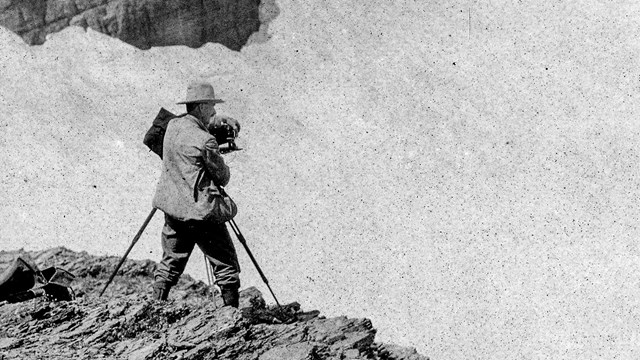
Glacier Repeat Photography
All the glaciers in the park are melting. Click here to find out why. |
Last updated: May 19, 2022
